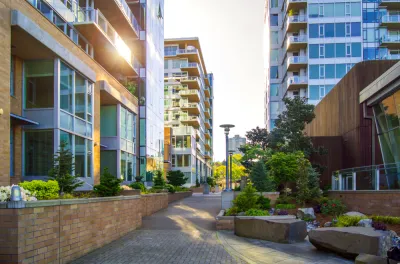The political will for zoning reforms has never been stronger. The traditional opponents of development, however, are still finding ways to push back.

Writing for the Lincoln Institute of Land Policy, Anthony Flint provides a detailed overview of zoning reform around the country, “from Connecticut to California,” with examples of the back-and-forth power play between local and state governments that is either enabling, or preventing, ongoing efforts to undo some of the strict requirements of 20th century zoning.
The article surveys many of the numerous jurisdictions that implemented zoning reforms in recent months, describing the issue as remarkably bipartisan. Flint credits the growing shortage of affordable housing in cities and communities all over the country for the new political will for reforms, but notes that there have also been setbacks.
“Responding to those who oppose any change in local regulations for development, state lawmakers have watered down statewide reform efforts by adding opt-outs or removing penalties for noncompliance,” including, according to Flint, in Utah and Massachusetts.
With these challenges in mind, Flint also offers advice for how to overcome traditional obstacles and build consensus for change:
States intent on reform must convince localities that changing zoning in targeted ways is achievable and will be beneficial. Technical assistance and education, facilitated by state agencies and nonprofit organizations, will help, said Massachusetts-based researcher Amy Dain, who has conducted research for the Lincoln Institute and has documented how suburban communities around Boston have erected a “paper wall” of bureaucracy that hobbles attempts by developers to build multifamily housing.
The article’s discussion of contemporary zoning also includes a history lesson, by mentioning the 1923 Standard State Zoning Enabling Act, which turns 100 this year, as the root of the power granted local governments in zoning. Flint suggests that statewide efforts are most effective to counteract local control.
The rationale for statewide standards, however, has become increasingly clear: to eliminate the patchwork of different policies and regulations within metropolitan regions. Some communities might allow ADUs, for example, while others prohibit them. A more uniform regulatory regime would level the playing field, reflecting actual homebuying and renting aspirations and making it possible to develop a responsive regional approach to issues like the current affordability crisis.
A lot more detail on the where, how, and why of zoning reform is available at the source article below.
FULL STORY: The State of Local Zoning: Reforming a Century-Old Approach to Land Use

Analysis: Cybertruck Fatality Rate Far Exceeds That of Ford Pinto
The Tesla Cybertruck was recalled seven times last year.

National Parks Layoffs Will Cause Communities to Lose Billions
Thousands of essential park workers were laid off this week, just before the busy spring break season.

Retro-silient?: America’s First “Eco-burb,” The Woodlands Turns 50
A master-planned community north of Houston offers lessons on green infrastructure and resilient design, but falls short of its founder’s lofty affordability and walkability goals.

Test News Post 1
This is a summary

Analysis: Cybertruck Fatality Rate Far Exceeds That of Ford Pinto
The Tesla Cybertruck was recalled seven times last year.

Test News Headline 46
Test for the image on the front page.
Urban Design for Planners 1: Software Tools
This six-course series explores essential urban design concepts using open source software and equips planners with the tools they need to participate fully in the urban design process.
Planning for Universal Design
Learn the tools for implementing Universal Design in planning regulations.
EMC Planning Group, Inc.
Planetizen
Planetizen
Mpact (formerly Rail~Volution)
Great Falls Development Authority, Inc.
HUDs Office of Policy Development and Research
NYU Wagner Graduate School of Public Service




























